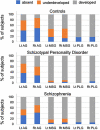Gross anatomical features of the insular cortex in schizophrenia and schizotypal personality disorder: Potential relationships with vulnerability, illness stages, and clinical subtypes
- PMID: 36465304
- PMCID: PMC9715601
- DOI: 10.3389/fpsyt.2022.1050712
Gross anatomical features of the insular cortex in schizophrenia and schizotypal personality disorder: Potential relationships with vulnerability, illness stages, and clinical subtypes
Abstract
Introduction: Patients with schizophrenia have a higher number of insular gyri; however, it currently remains unclear whether the brain characteristics of patients with schizotypal personality disorder (SPD), a mild form of schizophrenia, are similar. It is also unknown whether insular gross anatomical features are associated with the illness stages and clinical subtypes of schizophrenia.
Materials and methods: This magnetic resonance imaging study examined gross anatomical variations in the insular cortex of 133 patients with schizophrenia, 47 with SPD, and 88 healthy controls. The relationships between the insular gross anatomy and schizophrenia subgroups (71 first-episode and 58 chronic groups, 38 deficit and 37 non-deficit subtype groups) were also investigated.
Results: The number of insular gyri was higher in the schizophrenia and SPD patients than in the controls, where the patients were characterized by well-developed accessory, middle short, and posterior long insular gyri. The insular gross anatomy did not significantly differ between the first-episode and chronic schizophrenia subgroups; however, the relationship between the developed accessory gyrus and more severe positive symptoms was specific to the first-episode group. The prevalence of a right middle short gyrus was higher in the deficit schizophrenia group than in the non-deficit group.
Discussion: These findings suggest that schizophrenia and SPD patients may share an altered insular gross morphology as a vulnerability factor associated with early neurodevelopmental anomalies, which may also contribute to positive symptomatology in the early illness stages and clinical subtypes of schizophrenia.
Keywords: deficit schizophrenia; early neurodevelopment; gyrification; insula; magnetic resonance imaging; schizotypal.
Copyright © 2022 Takahashi, Sasabayashi, Takayanagi, Furuichi, Kobayashi, Yuasa, Noguchi and Suzuki.
Conflict of interest statement
The authors declare that the research was conducted in the absence of any commercial or financial relationships that could be construed as a potential conflict of interest.
Figures


Similar articles
-
Gross anatomical features of the insular cortex in affective disorders.Front Psychiatry. 2024 Dec 9;15:1482990. doi: 10.3389/fpsyt.2024.1482990. eCollection 2024. Front Psychiatry. 2024. PMID: 39717373 Free PMC article.
-
Anatomical variations in the insular cortex in individuals at a clinical high-risk state for psychosis and patients with schizophrenia.Front Psychiatry. 2023 Jul 5;14:1192854. doi: 10.3389/fpsyt.2023.1192854. eCollection 2023. Front Psychiatry. 2023. PMID: 37476540 Free PMC article.
-
Gross anatomical variations of the insular cortex in first-episode schizophrenia.Schizophr Res. 2023 Oct;260:23-29. doi: 10.1016/j.schres.2023.07.032. Epub 2023 Aug 7. Schizophr Res. 2023. PMID: 37549494
-
[The role of structural and functional insular cortex abnormalities in body perception disturbance in schizophrenia].Encephale. 2021 Jun;47(3):270-276. doi: 10.1016/j.encep.2020.11.004. Epub 2021 Apr 2. Encephale. 2021. PMID: 33814163 Review. French.
-
A review of structural MRI and diffusion tensor imaging in schizotypal personality disorder.Curr Psychiatry Rep. 2012 Feb;14(1):70-8. doi: 10.1007/s11920-011-0241-z. Curr Psychiatry Rep. 2012. PMID: 22006127 Free PMC article. Review.
Cited by
-
Gross anatomical features of the insular cortex in affective disorders.Front Psychiatry. 2024 Dec 9;15:1482990. doi: 10.3389/fpsyt.2024.1482990. eCollection 2024. Front Psychiatry. 2024. PMID: 39717373 Free PMC article.
-
Predicting mild cognitive impairment progression to Alzheimer's disease based on machine learning analysis of cortical morphological features.Aging Clin Exp Res. 2023 Aug;35(8):1721-1730. doi: 10.1007/s40520-023-02456-1. Epub 2023 Jul 5. Aging Clin Exp Res. 2023. PMID: 37405620
-
Causal links between personality disorders and schizophrenia: A Mendelian randomization study.Medicine (Baltimore). 2025 May 16;104(20):e42532. doi: 10.1097/MD.0000000000042532. Medicine (Baltimore). 2025. PMID: 40388757 Free PMC article.
-
Anatomical variations in the insular cortex in individuals at a clinical high-risk state for psychosis and patients with schizophrenia.Front Psychiatry. 2023 Jul 5;14:1192854. doi: 10.3389/fpsyt.2023.1192854. eCollection 2023. Front Psychiatry. 2023. PMID: 37476540 Free PMC article.
-
Increased brain gyrification and cortical thinning in winter-born patients with schizophrenia spectrum.Front Psychiatry. 2024 Apr 24;15:1368681. doi: 10.3389/fpsyt.2024.1368681. eCollection 2024. Front Psychiatry. 2024. PMID: 38721613 Free PMC article.
References
LinkOut - more resources
Full Text Sources

